
About the Apiary
An informative and sometimes humorous column published in
The New Zealand Beekeeper Journal
IT’S TIME TO WINTER YOUR HIVES
About the Apiary - April - 2016Autumn is upon us. Days are getting shorter. Night-time temperatures are falling; dew is appearing on the lawns overnight. The poplar and willows have turned yellow and have started losing their leaves. The skinks in the garden are growing fat tails. All these signs point to winter not being far away.
As I write this, lacebark (Hoheria populnea) is in full flower with bees all over the flowers; likewise koromiko (Hebe stricta). Where there’s been rain, catsear (Hypochaeris radicata) and lotus major (Lotus pedunculatus) are in flower. Along the railway lines, fennel (Foeniculum vulgare) is just finishing. Gorse (Ulex europaeus) has started flowering, providing much- needed pollen.
With the warm, dry summer around Wellington, the spider mites have managed to establish on the gorse but there’s still a lot of gorse around.
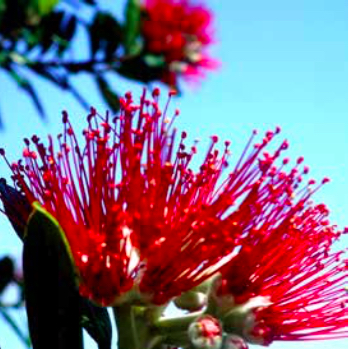
One puzzling thing has been the lack of pohutukawa honey in the hives for the last three years. It has flowered well but hasn’t produced a lot of nectar. Normally when you shake the flowers onto your hand, it will be covered in nectar, but that’s not happening recently.
In the rural areas where it’s been particularly dry, there’s hardly a blade of grass and the bees are in defensive mode. Further north where they have had rain, the bees are fanning at the entrance in the evening, suggesting there’s a nectar flow on.
For the first time I have seen giant willow aphids (Tuberolachnus salignus) on the willow cuttings in my garden. I hadn’t noticed them earlier but spotted wasps hanging around so dispatched them with a spray of dishwashing liquid and water. I hope this isn’t the cause of the flow in my hives further north, as it crystallises as hard as concrete. Willow honey is quite pleasant when first extracted but then becomes bitter over time.
Beyond my little patch in some select areas such as the central North Island desert, heather (Calluna vulgaris) continues to yield. In the South Island around the ranges, honey dew will start to be produced once it has rained.
I did a quick trip north in early March. While driving through the Desert Road, I was surprised at the number of bees that met their end when struck by our car. The apiaries there are fairly close together and very close
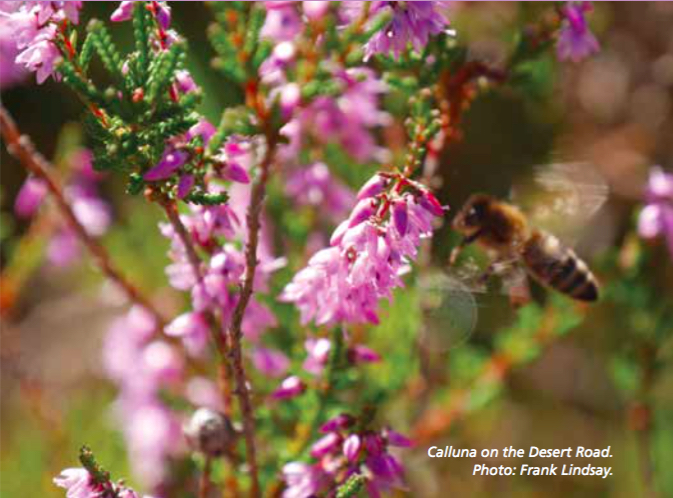
to the road because of the difficult terrain. The bees were gathering Calluna nectar in mild, wind-free conditions, but countless numbers were being collected by passing vehicles. This must have a detrimental effect on the colonies and could affect the wintering of the hives. I was told at a garage that it also upsets the bus drivers as they have to clean their vehicles and nectar, once dried, takes a little elbow grease to remove.
Advice for wintering hives
Pretty soon we will see another sign that winter is coming. When the nectar flow ceases, the queen will reduce her laying and if she is a good queen, the bees will start to expel the drones. When this happens, queen rearing for the season ceases, unless you continue to feed sugar syrup to drone colonies or make them queenless. Queen cell-producing colonies also have to be fed to simulate a spring nectar flow.
I have discussed in recent articles the requirements for wintering bees. These are:
• lots of young ‘mite-free’ bees filling the super(s) • a young queen laying well and • a good supply of honey and pollen frames in at least one full-depth super (or the equivalent if using three-quarter- depth supers).
If you don’t have a full super of honey, feed now (put the feeders on after dark to discourage robbing). Some will have top feeders or division board feeders but if you don’t, use a large Milo or coffee tin and put a couple of dozen small brad holes in the lid. Feed a ratio of two parts sugar to one part of water over the top super.
Make a crown board out of coreflute rather than cut a hole in your crown board. Cut a hole in the coreflute the size of the tin, upend the feeder tin and place it on a couple of runners so the bees can easily access the holes in the lid. A hive should take two litres a day, so monitor and keep feeding until the desired amount of stores is achieved.
Bees can winter in a box of any size, even a small nuc box, provided the bees completely fill the box as this allows them to regulate the temperature in the cluster.
Small colonies can die in a harsh winter if there aren’t enough bees. Small colonies become stressed and Nosema can develop in the bees, shortening their life. They may have a fighting chance if the colony is placed on top of a regular hive. (The heat given off by the colony below helps the nuc bees to regulate their colony temperature). The key thing is to make sure the colony is full of bees.
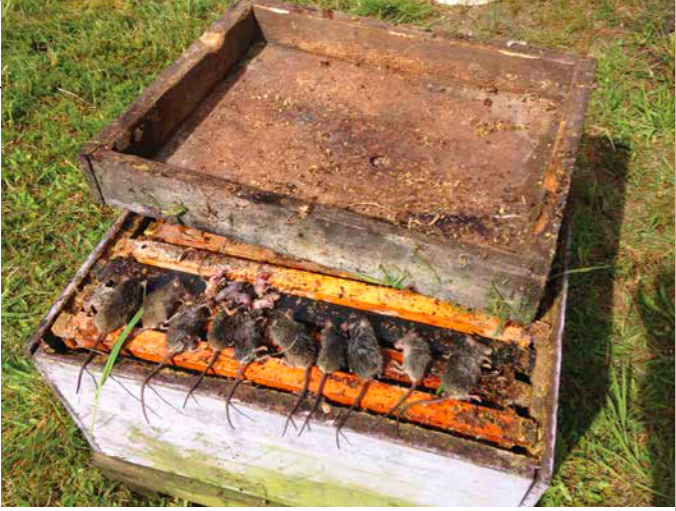
Ventilating the hive
A topic I haven’t discussed in recent articles is ventilation. Bees give off water vapour, warm air rises and the water vapour can condense when it hits a cold surface. I provide a small opening in my split/crown boards to allow the moist air to get away. I need to do this because quite a few of my apiaries are not in full sun during the winter. Moisture can build up and cause mould to grow in the outside damp frames.
It may not be necessary to provide top ventilation if you have open mesh bottom boards. The bees can generally move any moist air out if these are on the hives.
Pests, including the human variety
I’m also putting out baits for the mice and rats around my apiaries, placing the baits in an empty plastic container with a fairly wide mouth (just big enough for a rat to get in). I place three baits in each and check them regularly. These bait stations (three in each apiary) are placed under the pallets or hives away from any birds.
One can tell when a rat is around, as it will move the plastic bottle a few metres away from its original position, perhaps trying to move them to their nest. By wiring in the baits, the mice and rats are required to eat the baits then and there, instead of storing for winter. I don’t particularly like these rodents because they cause so much damage to supers and frames. A few mice can ruin a stack of supers by urinating all over the frames and eating away the dark wax or any with pollen.
My best total catch is 14 mice in a dead-out hive (three generations of mice in the spring).
I take great pleasure in dispatching them if they have damaged my frames. I block any holes they have made and then remove a few frames at a time, gradually reducing the hive to two supers high. Mice can quickly jump out of a single super but can’t jump two full-depth supers high. I gradually remove most of the frame and then use the hive tool to dispatch them as they hide between the frames.
The other nuisance species we sometimes come across, especially in public areas during school holidays, is the teenage boy. This species just likes to push over hives for a dare. They never think of the consequences and are often well away when the bees react.
An open hive is an invitation to all the nearby wasps to come to a free dinner. The only problem is that once they get the smell of a hive on them, they continue to raid all the other hives near the fallen hive, taking everything: bees, brood and honey.
Even though the best time to kill them has passed, Vespex can still do the job when all the wasps in an area are concentrating on your hives. Close the entrances and start feeding them poison baits. This stuff should work within an hour. This is the only registered product that can be used to bait wasps. It has to be monitored so that no other invertebrates are poisoned. The only alternative is to find the nest and smother it with fuel (petrol, etc). To locate wasp nests (other than standing on them), follow the wasps as the fly home. The best time is just after the bees have finished flying when the sun is low and bright.The sunlight reflects off their wings as they fly straight back to the nest.
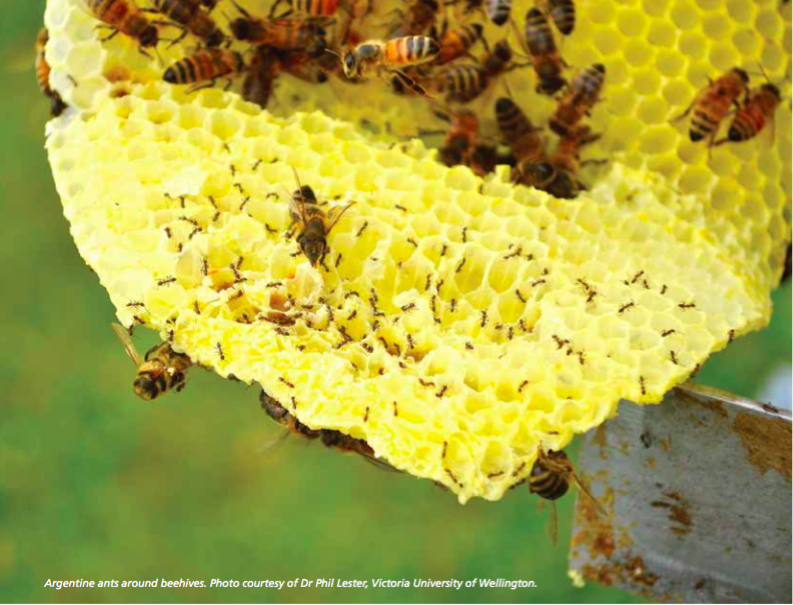
Wasps make nests in dry banks and soft ground where a root has rotted. They start small and excavate the cavity as their numbers increase through the summer.
Robbing season starts when the nectar flow ceases. Twenty thousand bees with nothing to do will begin probing hives nearby for weakness. Any under-strength hives will be targeted. Close down entrances. Put robbing screens on nucs. These can be as simple as a 100-mm square of fly screen stapled or pinned across the entrance, leaving a finger-sized tunnel to the side for the bees to use. Robbers are attracted to the hive smell emulating from the entrance and will be drawn to it rather than the tunnel entrance.
Ants? I only get the tiny Australian ant that builds colonies on top of the crown boards. These are easily dispatched by hand, or sometimes I apply some formic acid to kill
them. They don’t like a damp environment, so a branch of green leaves left under the roof will dissuade them from returning.
Improving apiary biosecurity
One thing we don’t do well in New Zealand is apiary biosecurity; that is, preventing anything from spreading to another apiary.
In Australia, farmers are strict about where you go and what you bring onto the farm. We have Argentine ants in several area of New Zealand. They are becoming a problem to beekeepers there, as they take over beehives, often eating the brood and the honey.
Are our migratory beekeepers checking and cleaning ants off their pallets and under their bottom boards (using disinfectant) before moving hives? I for one don’t want to see ants brought down from Northland or Gisborne to within close proximity of my hives. Once ants establish in an apiary, it makes it difficult to continue to keep bees there.
Check out Plant Health Australia’s website for more information on what we should all be doing: http://www.farmbiosecurity.com.au/ videos/
Also check out the bee industry section of the Plant Health Australia website for more good information: http://www.planthealthaustralia. com.au/industries/honey-bees/
Plant Health Australia looks after beekeeping rather than Animal Health Australia, as bees and beekeepers relate to plants and pollination rather than cattle. Learn more at the Apiculture New Zealand National Conference at Rotorua in June.
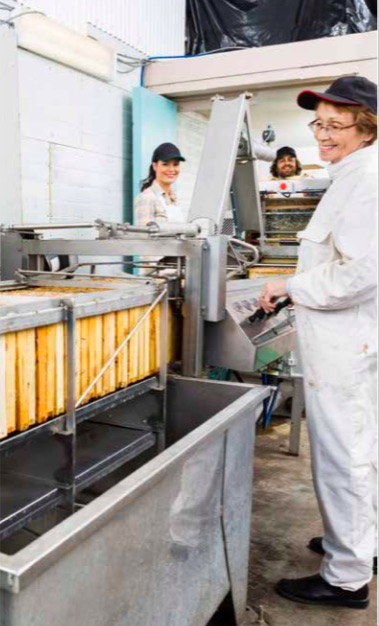
TIP:
Nothing is worse than seeing a stainless-steel plant water-stained. You can prevent staining by polishing the outside of new equipment with food grade mineral oil on a nylon stocking. Polish it well into the pours in the stainless steel. Then it’s just a matter of repeating this after the final clean-down for the season.For those with JB horizontal radial extracting plants, the rails can be polished weekly so that the frames slide easily into and out of the extractor.
THINGS TO DO THIS MONTH
Winter down hives. Check feed, as some hives have been brooding up and could have used the honey you left on the hive. Check the effectiveness of your mite treatments. Make sure top-bar hives have 10 frames with honey in them. Feed now rather than later in the spring.
Carry out an AFB check, especially after the robbing season has finished. Slope bottom boards to the front so rain runs out of the hive. Fit mouse guards or reduce entrances to 400 mm x 8 mm. Replace rotten or damaged supers and bottom boards. Attend to fences, check for wasps and control grass.
During extraction, go through the honey supers and reject any old, dark frames you cannot see light through. Replace these with a new foundation frame. Store frames with foundation or light frames on the outside with darker ones towards the middle. Freeze stored supers to kill wax moth eggs and larvae or store in a shed that is open and well lit, and provides a good airflow through the supers. (Fit queen excluders top and bottom to prevent mouse damage.)
Drought means possible tutin problems. If you have tutu bushes within five kilometres and high passion vine hopper (Scolypopa australis) numbers, test your honey. From observations, numbers are high again this year. Any honey sold or bartered has to be tested for tutin. Clubs can have their members’ samples composite tested to save money. Send the results to MPI. Check out the new tutin regulations on the MPI website.
Frank Lindsay